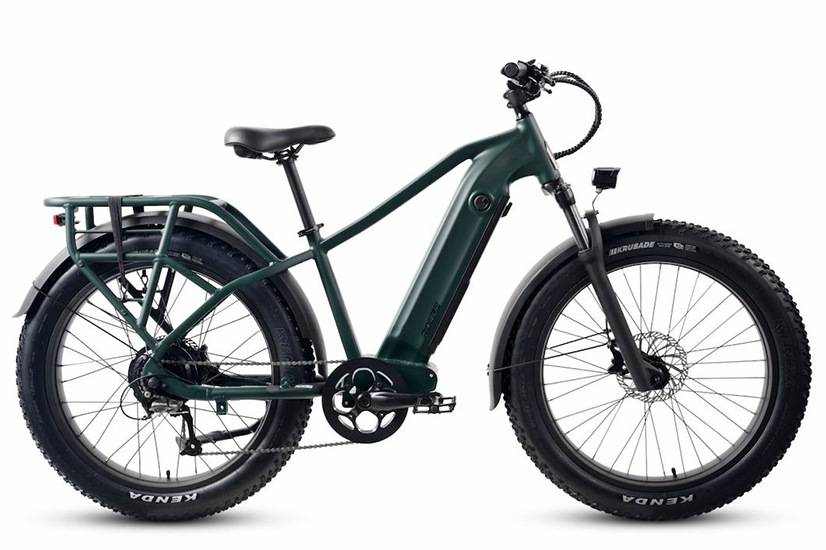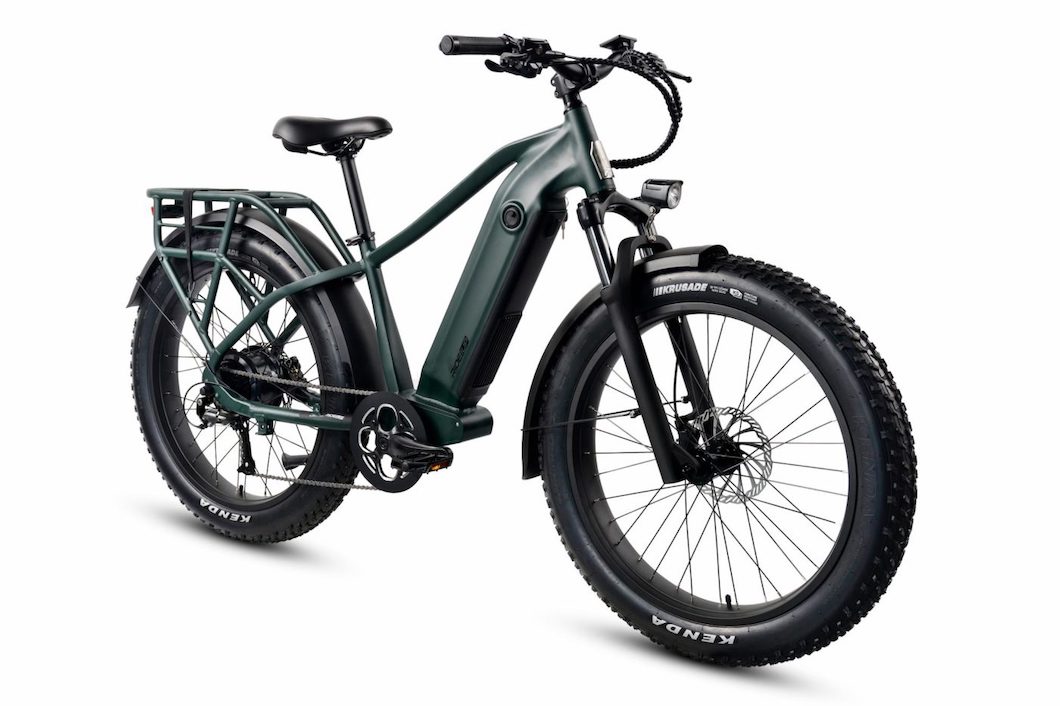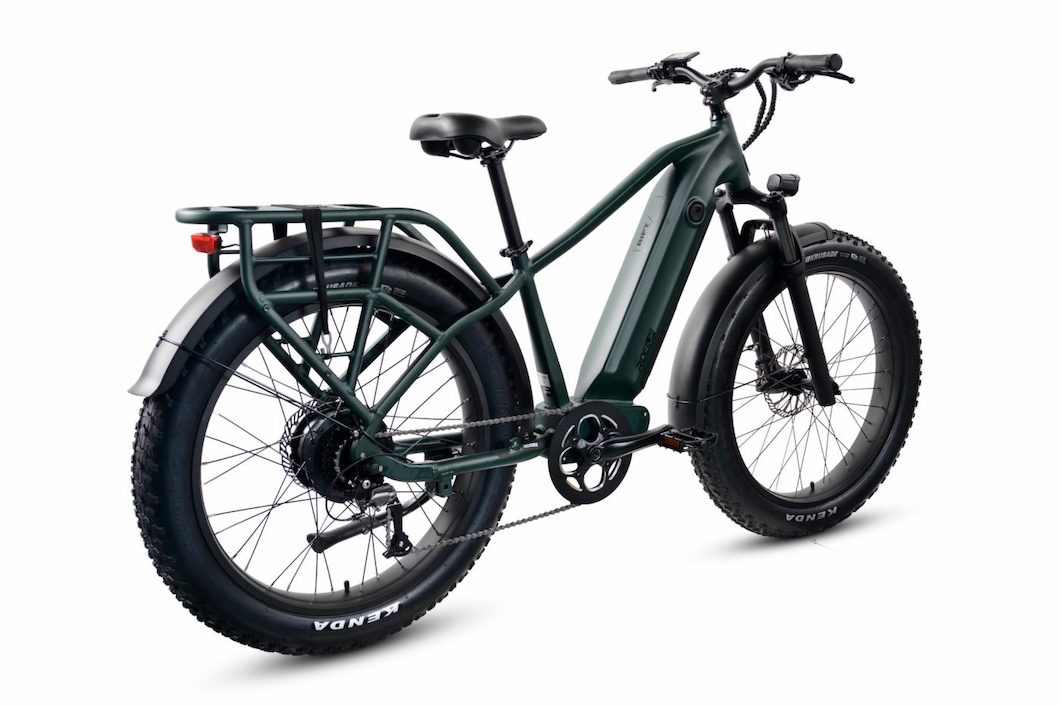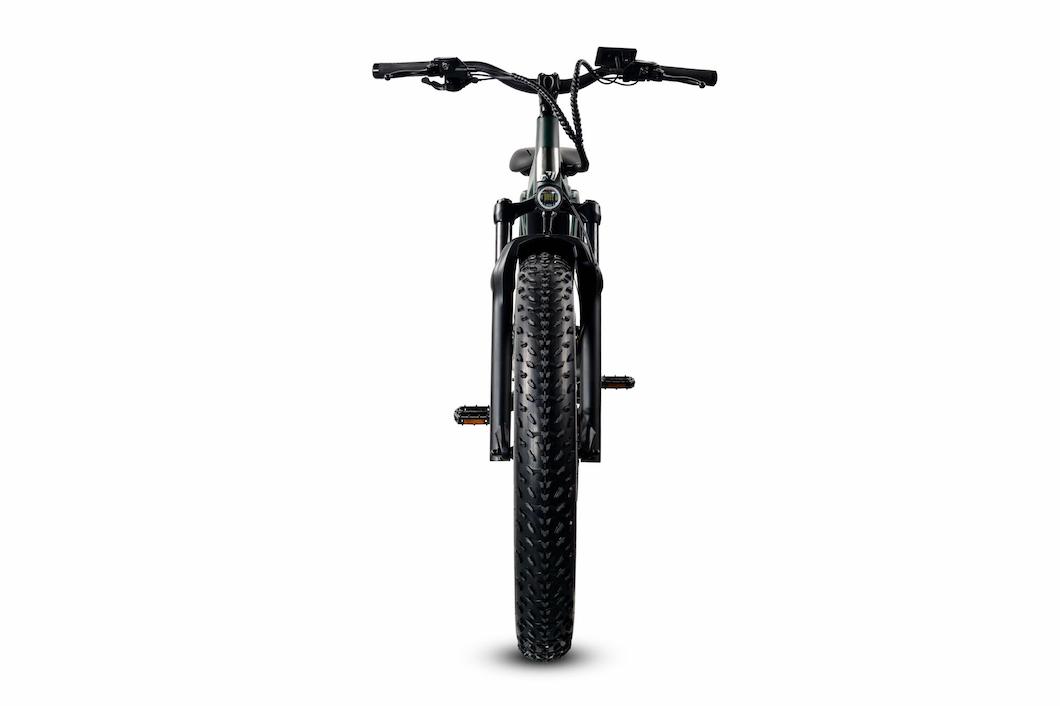Ride1UP Rift First Look Review: Real Off-Road Ability

Trickle-down may not work in economics, but in manufacturing it does. As tooling ages, the cost to produce parts from those tools drops. This is why two years ago a sub-$2000 e-bike might include a big battery or a powerful motor or an 8-speed drivetrain or premium hydraulic disc brakes, but it wouldn’t include all four. In our review of the Ride1UP Rift we will dig into the details that make this a very exciting addition to the Ride1UP lineup.
*Ride1Up has discountinued the Rift, but here are some other e-bikes from the brand worth checking out:
Ride1Up Portola Review
Ride1Up CF Racer 1 Review
Ride1Up Turris Review
Ride1UP Rift Spec Review: Bike Overview

The Rift is aimed at a rider other than those who have been buying Ride1UP e-bikes. Until now, their models have been aimed at riders who planned to stick to the pavement. Thanks to a 750W hub motor that produces 95Nm of torque, knobby 4-in.-wide tires and a suspension fork, the Rift is intended to go places a lesser bike wouldn’t handle.
We see a great many fat-tire e-bikes that make bold claims about off-road abilities suitable to the Red Bull set. The fact is, many of these e-bikes won’t ride well on anything more rigorous than a crushed gravel path. The Ride1UP Rift isn’t an eMTB, but it may be one of the most off-road capable sub-$2000 e-bikes we’ve encountered.
Ride1UP Rift Review: Specs & Features

The Rift is aimed at a rider other than those who have been buying Ride1UP e-bikes. Until now, their models have been aimed at riders who planned to stick to the pavement. Thanks to a 750W hub motor that produces 95Nm of torque, knobby 4-in.-wide tires and a suspension fork, the Rift is intended to go places a lesser bike wouldn’t handle.
We see a great many fat-tire e-bikes that make bold claims about off-road abilities suitable to the Red Bull set. The fact is, many of these e-bikes won’t ride well on anything more rigorous than a crushed gravel path. The Ride1UP Rift isn’t an eMTB, but it may be one of the most off-road capable sub-$2000 e-bikes we’ve encountered.
Frame and fork
Like Ride1UP’s other offerings, the Rift’s frame is a very stout 6061 aluminum creation with a large, hydroformed aluminum down tube to hold the internal battery. The top tube has a slight curve to it, which recalls other other Ride1UP models like the 700 and Prodigy. The Rift comes in two frame designs, both a traditional version with a sloping top tube and a step-thru model. The two frames are essentially the same size; they each feature a 17-in. seat tube and a 15-in. reach; choosing one over the other is a matter of preference more than fit.
Ride1UP takes the Rift’s off-road ability seriously as proven by the fork they chose for it. The air-spring design and 120mm travel tell the shopper that Ride1UP is serious about the Rift making its way in the wilds.
Another notable feature of the Rift is that its rack is incorporated into the frame, welded on rather than bolted on. This reinforces the frame, making it stronger than it would be otherwise, and underscoring the Rift’s payload capacity of 350 lbs.; the rack can carry up to 150 lbs.
Motor and battery
The beating heart of the Rift is its 750W brushless, geared hub motor. While most Ride1UP models are capable of Class 3 speeds, because the Rift is built for off-road use, the torque this particular motor produces is higher than usual at 95Nm. That will give the Rift excellent acceleration on soft surfaces as well as the ability to climb steep roads, whether they are paved or not.
The Rift ships as a Class 2 e-bike, meaning it has a top assist and throttle speed of 20 mph, but it can be unlocked so that it can offer riders pedal-assisted top speeds
The 48V, 960Wh battery is estimated to offer riders between 45 and 60 mi. of range per charge. The projected range isn’t more definitive because not only does rider weight and how hilly the terrain is influence range, but whether the e-bike is on pavement or off makes a substantial difference in range.
Components
One recurring theme of Ride1UP’s e-bikes is the use of 8-speed drivetrains. Any time an e-bike features an 8-speed drivetrain, rather than a 7-speed one, that drives up the cost a bit. What the customer gets for that extra spend, when compared to what we usually see at that price point, is a wider range of gears to make climbing easier, smaller jumps between gears thanks to the extra cog and smoother shifting. This last point is something we probably haven’t talked enough about in other reviews. With 8-speed drivetrains the cassette teeth feature special profiles that make shifting easier—and quicker. There’s less plastic overall as well, so the drivetrain carries a notably stronger air of quality. And in most cases, the 8-speed drivetrain weighs less because of an increased use of aluminum over steel.
Here at EBR we praise hydraulic disc brakes as almost uniformly superior to mechanical disc brakes. There are plenty of very good mechanical disc brakes, but hydraulic disc brakes tend to enjoy both a smoother feel and more power. However, not all hydraulic disc calipers are created equal. We’ve seen some brakes spec’d on fat-tire e-bikes that were designed for bikes that weigh half as much. With the Rift, Ride1UP went with 4-piston calipers, meaning each brake has two sets of pistons for even more braking power, which is not a bad thing consider this e-bike tips the scales at 85 lbs.
As we mentioned at the opening of the review, the Rift ships as a Class 2 e-bike thanks to the inclusion of a throttle which provides an out for tired legs. Riders looking for more speed can unlock the controller so that the 750W motor can help the rider reach a maximum pedal-assist speed of 28 mph.
There are plenty of touches that show the Rift was created by people who know what they are doing. The 680mm-wide handlebar, the ergo gel saddle, lock-on grips, front and rear lights and front and rear fenders all contribute to the sense that this is a carefully designed and competitively priced e-bike.
EBR’s Ride1UP Rift First Look Review:
As recently as six months ago if we’d looked at the specs for the Ride1UP Rift and were asked what we thought it would cost, we would have guessed north of $2000, not south of that mark. The Rift is the sort of step up in this category that will cause other e-bike makers to look at how they might improve the value of their fat-tire models, or, it ought to.
Bike reviewers are famous for second-guessing the choices made by a bike company’s product manager. Without knowing what requirements and hard-stops the product manager was given, judging an e-bike harshly can be unfair. It is with said that we offer our one criticism of the Rift: We wish it had been spec’d with a torque sensor.
Including a torque sensor would be the only other touch Ride1UP could have undertaken that would serve to further blur the line between this fat-tire e-bike and an eMTB. A torque sensor would undoubtedly increase the cost of the Rift and Ride1UP made the election not to include it in order to hit their chosen price point.
The torque sensor is a minor knock and the sort of detail that many riders would enjoy, but probably won’t miss. We think this is a terrific e-bike that shows real attention to detail.
With summer right around the corner, many shoppers are thinking of exploring out of the way places, getting away from the city to recharge. The Ride1UP Rift is an impressive new option for the off-road set.




